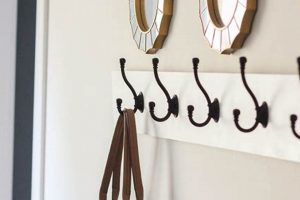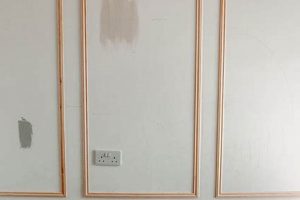A self-constructed horizontal bar, designed for upper body exercises such as chin-ups and pull-ups, is affixed to a vertical surface utilizing mounting hardware. This fitness apparatus allows individuals to perform bodyweight training within a residential or personal gym environment. The design prioritizes secure attachment to a structural wall to ensure user safety during exercise. Examples include units constructed from metal piping or wooden beams, each tailored to the user’s strength requirements and available space.
Constructing such an apparatus offers several advantages, including cost savings compared to purchasing pre-fabricated equipment and the opportunity to customize dimensions to suit individual needs and spatial constraints. Historically, individuals have sought methods to train using bodyweight, adapting readily available materials for this purpose. The ability to build a customized fitness solution addresses concerns related to space limitations and specific strength training goals often unmet by commercially available products. The importance of such an installation lies in its ability to promote consistent strength training within a convenient and accessible environment.
The following sections will elaborate on design considerations, material selection, construction techniques, and safety protocols essential for the successful creation of a secure and functional home fitness station. Detailed instructions and cautionary measures will be provided to ensure a robust and safe apparatus for effective bodyweight training.
Construction and Installation Guidance
The following points provide crucial guidance for the successful and safe creation and mounting of a pull-up bar to a wall. Adherence to these considerations will contribute significantly to the stability and long-term usability of the fitness apparatus.
Tip 1: Material Selection: Prioritize high-strength steel or appropriately rated hardwood for the horizontal bar. Ensure the chosen material can withstand substantial weight and repeated stress without deformation or failure. Consider a minimum diameter of 1.25 inches for steel piping to ensure adequate grip and structural integrity.
Tip 2: Mounting Hardware: Employ heavy-duty lag screws or bolts specifically designed for structural applications. Select fasteners of adequate length to penetrate deeply into the wall studs or concrete. Verify the load rating of the chosen hardware exceeds the anticipated maximum load by a significant margin of safety.
Tip 3: Wall Structure Assessment: Identify load-bearing wall studs using a stud finder. For concrete walls, ensure the concrete is structurally sound and free from cracks or crumbling. Avoid mounting to hollow walls without reinforcement.
Tip 4: Proper Spacing: Position the mounting brackets at a distance that aligns precisely with the location of the wall studs. Standard stud spacing is typically 16 or 24 inches on center. Ensure the horizontal bar extends far enough from the wall to allow for a full range of motion during exercise, preventing contact with the wall.
Tip 5: Secure Attachment: Pre-drill pilot holes slightly smaller than the diameter of the lag screws or bolts to facilitate easier installation and prevent splitting of wood studs. Tighten fasteners securely using appropriate tools, ensuring a firm and unyielding connection between the mounting brackets and the wall.
Tip 6: Level Installation: Utilize a level to ensure the horizontal bar is perfectly level during installation. This contributes to uniform weight distribution and minimizes stress on the mounting hardware.
Tip 7: Load Testing: Before commencing regular use, subject the installed unit to a static load test. Gradually apply weight to the bar, exceeding the anticipated user weight. Inspect the mounting hardware and wall attachments for any signs of movement, stress, or deformation.
Effective execution of these guidelines contributes to a secure and reliable fitness installation. Prioritizing structural integrity and adherence to established construction principles is paramount for user safety.
Implementing these recommendations establishes a foundation for the successful execution of the project. The subsequent stage will focus on addressing frequently encountered challenges and implementing resolutions to ensure project completion.
1. Structural Integrity
Structural integrity is paramount in the design and construction of a self-constructed horizontal bar affixed to a wall, as it directly impacts user safety and the long-term reliability of the fitness apparatus. The ability of the structure to withstand applied forces without failure is a non-negotiable requirement.
- Material Resistance to Yielding
The materials used for both the horizontal bar and the mounting brackets must possess a yield strength sufficient to withstand the anticipated load. For example, using Schedule 40 steel pipe is preferable to thinner-walled alternatives due to its higher yield strength. Failure to consider this could result in permanent deformation or catastrophic failure of the bar under load.
- Fastener Load Capacity
The fasteners connecting the mounting brackets to the wall must be rated to handle significantly more weight than the expected user. Employing undersized lag screws or failing to properly anchor them into wall studs compromises the entire structure. A suitable example involves using -inch diameter lag screws embedded at least 3 inches into solid wood studs, as opposed to shorter screws or drywall anchors. Inadequate anchoring can lead to the bar pulling away from the wall during use.
- Weld Integrity (If Applicable)
When metal components are joined by welding, the welds must be performed by a qualified welder and inspected for defects. Porosity, incomplete fusion, or insufficient weld penetration can create weak points that can lead to failure. A common instance is a T-joint between the horizontal bar and the mounting bracket; this joint requires a strong, full-penetration weld to ensure structural stability.
- Load Distribution and Stress Concentration
The design of the mounting brackets should distribute the load evenly across the wall and minimize stress concentrations. Sharp corners or abrupt changes in cross-section can create points of high stress that are prone to failure. For example, using curved or rounded bracket designs, rather than sharp-angled ones, helps to distribute the load more effectively and reduce stress concentrations at the mounting points.
These facets of structural integrity are not independent but rather interconnected components essential to the overall safety and functionality of a wall-mounted exercise bar. Neglecting any one aspect significantly increases the risk of failure, emphasizing the importance of careful planning, material selection, and meticulous execution during construction. The principles outlined are fundamental to creating a fitness apparatus capable of reliably supporting the intended weight and forces without compromising user safety.
2. Material Selection
Material selection is a critical determinant of the safety, durability, and overall performance of a self-constructed horizontal bar affixed to a wall. The chosen materials must withstand the stresses imposed by repetitive bodyweight exercises and resist degradation over time. Improper material selection introduces significant risks, potentially leading to structural failure and user injury.
- Steel Piping
Steel, specifically Schedule 40 steel piping, is commonly employed due to its high tensile strength and resistance to deformation. The diameter and wall thickness of the piping directly influence its load-bearing capacity. For instance, a 1.25-inch diameter Schedule 40 steel pipe offers a suitable grip and can support substantial weight. Conversely, thinner-walled or lower-grade steel may yield or fracture under stress, posing a significant safety hazard.
- Hardwood Lumber
Certain hardwoods, such as maple or oak, offer an alternative to steel for the horizontal bar. These woods possess high strength-to-weight ratios and can provide a comfortable grip. However, wood is susceptible to moisture damage and rot, necessitating proper sealing and maintenance. A hardwood bar must be of sufficient diameter (e.g., 1.5-2 inches) to prevent bending or cracking under load. In comparison to steel, hardwood requires more frequent inspection and potential replacement due to environmental factors.
- Mounting Bracket Materials
The materials used for the mounting brackets must be compatible with the horizontal bar material and the wall structure. Steel brackets are typically welded or bolted together, offering high strength and rigidity. Wood brackets, while potentially aesthetically pleasing, require careful design and robust joinery to ensure adequate support. The use of dissimilar metals (e.g., aluminum brackets with a steel bar) can lead to galvanic corrosion, weakening the structure over time.
- Fastener Grade and Type
The grade and type of fasteners (lag screws, bolts, etc.) used to secure the brackets to the wall are crucial for the overall stability of the apparatus. High-strength fasteners, such as Grade 8 bolts, are recommended for their superior shear and tensile strength. The fastener length must be sufficient to penetrate deeply into wall studs or concrete, providing a secure anchor. Substituting lower-grade fasteners compromises the integrity of the entire system, regardless of the quality of the horizontal bar or brackets.
The careful consideration and selection of appropriate materials are fundamental to the successful construction and safe operation of a self-constructed horizontal bar attached to a wall. Each component, from the horizontal bar itself to the mounting hardware, must be chosen based on its strength, durability, and compatibility with other materials. Neglecting these material considerations compromises the structural integrity of the apparatus and exposes the user to unnecessary risks.
3. Secure Anchoring
Secure anchoring forms a critical and indispensable element in the successful implementation of a self-constructed horizontal bar affixed to a wall. This aspect addresses the method by which the apparatus is firmly and reliably attached to the supporting wall structure. Improper or inadequate anchoring precipitates structural failure, potentially resulting in severe injuries to the user. The integrity of the entire exercise station hinges directly on the robustness and effectiveness of the chosen anchoring techniques.
A failure in secure anchoring exhibits a direct cause-and-effect relationship with the stability of the pull-up bar. For instance, if lag screws of insufficient length are employed to secure the mounting brackets to wall studs, the apparatus may detach from the wall during use, causing the user to fall. Similarly, utilizing drywall anchors instead of fasteners anchored directly into studs or concrete will invariably lead to a collapse under load. The practical significance of understanding secure anchoring is underscored by the need to select appropriate fasteners, accurately locate wall studs, and apply proper installation techniques. An example illustrates this point: a successful installation requires the use of heavy-duty lag screws that penetrate at least three inches into solid wood studs, ensuring a strong and reliable connection. Conversely, a deficient installation relying on shorter screws or inadequate stud location creates a high-risk environment for injury.
In conclusion, secure anchoring represents a non-negotiable safety consideration in the context of a horizontal bar affixed to a wall. The appropriate selection and installation of anchoring hardware are fundamental to the stability and reliability of the structure. Challenges associated with secure anchoring often involve identifying suitable wall structures and determining appropriate fastener types. Addressing these challenges with meticulous attention to detail ensures a safe and effective exercise environment.
4. Precise Alignment
Precise alignment is an indispensable prerequisite for the structural integrity and safe functionality of a horizontal bar affixed to a wall. Deviations from accurate horizontal and vertical positioning introduce asymmetric load distribution, thereby increasing stress on specific mounting points and potentially compromising the long-term stability of the apparatus. The connection between this critical alignment and the overall effectiveness of a self-constructed horizontal bar lies in its direct influence on user safety and equipment longevity. For example, if the horizontal bar is not perfectly level, one mounting bracket will bear a disproportionate share of the user’s weight, accelerating wear and tear on that specific anchor point. This uneven stress distribution increases the risk of premature failure and potential injury.
The importance of precise alignment extends beyond preventing immediate structural failure. Misalignment can also lead to subtle but cumulative damage over time. Repeated use under asymmetrical loading conditions gradually weakens the anchoring points, eventually exceeding their design capacity. Consider a scenario where the mounting brackets are slightly skewed. This misalignment introduces torsional stress on the horizontal bar, potentially leading to deformation or fatigue cracking, especially if the bar is constructed from a less robust material. Accurate leveling and squaring of the components during installation are crucial to mitigating these risks. Employing a spirit level and framing square to ensure precise alignment is not merely a cosmetic consideration; it is a fundamental safety precaution.
In summary, precise alignment is not an optional refinement but a critical engineering parameter in the construction of a horizontal bar attached to a wall. Its accurate execution is essential to ensuring symmetrical load distribution, preventing premature wear, and safeguarding the user from potential injury. Overlooking this aspect compromises the entire installation, highlighting the significance of diligent measurement and careful execution during the construction process. Challenges associated with achieving precise alignment typically involve accounting for irregularities in wall surfaces and ensuring accurate positioning of mounting brackets. Addressing these challenges with meticulous attention to detail guarantees the stability and safety of the exercise apparatus.
5. Ergonomic Design
Ergonomic design principles are paramount when constructing a self-assembled horizontal bar affixed to a wall. This design discipline aims to optimize the interaction between the user and the equipment, prioritizing safety, comfort, and efficiency during exercise. Ignoring ergonomic considerations can lead to discomfort, injury, and reduced training effectiveness. The following facets elaborate on key ergonomic aspects essential for a functional and safe exercise apparatus.
- Grip Diameter and Material
The diameter of the horizontal bar directly impacts grip strength and hand fatigue. A diameter that is too small can be difficult to grip securely, while one that is too large can strain the hand muscles. A diameter between 1.25 and 1.5 inches is generally considered optimal for most users. The surface material also influences grip. Knurled steel provides excellent grip but can be abrasive, while smooth steel may be slippery. Rubber or foam grips offer a compromise between comfort and grip security. Selecting a grip diameter and material appropriate for the user’s hand size and preferences minimizes strain and enhances performance.
- Bar Extension from Wall
The distance the horizontal bar extends from the wall is crucial for allowing a full range of motion during pull-ups and chin-ups. Insufficient extension can cause the user’s body to contact the wall, restricting movement and potentially leading to injury. A minimum extension of 18 inches is generally recommended to accommodate most body sizes. The specific extension may need to be adjusted based on individual body dimensions and exercise preferences. An inadequate bar extension may result in improper form and increase the risk of scraping against the wall, thereby diminishing the effectiveness and safety of the exercise.
- Vertical Clearance
Adequate vertical clearance above the horizontal bar is essential to prevent head injuries during exercise. The user must have sufficient space to fully extend their arms without striking the ceiling. The required vertical clearance depends on the user’s height and the mounting height of the bar. A minimum of 6 to 12 inches of clearance above the user’s extended reach is recommended. Insufficient vertical clearance poses a direct threat of head injury, hindering the proper execution of the exercise and potentially causing serious harm.
- Mounting Height
The mounting height of the horizontal bar should be determined based on the user’s height and arm length. The bar should be positioned high enough to allow the user to hang freely with their arms fully extended, without their feet touching the ground. However, the bar should not be so high that the user struggles to reach it safely. A step stool or platform can be used to assist with reaching the bar, but it should be stable and secure. Incorrect mounting height can lead to strain on the shoulders and back, as well as an increased risk of falls.
The ergonomic design considerations detailed above are critical to maximizing the safety, comfort, and effectiveness of a self-assembled horizontal bar attached to a wall. By carefully selecting materials, dimensions, and mounting parameters, it is possible to create a fitness apparatus that promotes proper form, minimizes injury risk, and enhances the overall training experience. Neglecting these ergonomic factors compromises the usability and safety of the equipment, potentially negating the benefits of bodyweight training. Prioritizing ergonomic principles ensures a sustainable and injury-free exercise routine.
6. Load Capacity
Load capacity represents a critical engineering parameter inextricably linked to a self-constructed horizontal bar affixed to a wall. This term defines the maximum weight or force the apparatus can safely withstand without experiencing structural failure or permanent deformation. In the context of a do-it-yourself pull-up bar, load capacity dictates the safety margin for users performing exercises. A direct cause-and-effect relationship exists: exceeding the specified load capacity inevitably leads to material yielding, fastener failure, or complete structural collapse, thereby posing a substantial risk of serious injury. For instance, if a self-built unit, designed to support 200 pounds, is subjected to a 250-pound load, critical components such as the horizontal bar or mounting brackets may bend, buckle, or detach from the wall.
The importance of load capacity assessment stems from its role as a primary safety determinant. A comprehensive understanding of material properties, fastener strengths, and structural design is paramount in accurately calculating the load capacity of a self-constructed pull-up bar. Real-world examples underscore this point. If an individual constructs a pull-up bar using low-grade steel piping and secures it with undersized lag screws, the resulting apparatus will possess a significantly reduced load capacity compared to a unit built with high-strength steel and robust anchoring. A failure to properly calculate and account for load capacity often results in catastrophic equipment failure under normal operating conditions. Static load testing, involving the gradual application of weight to the bar, serves as a practical method to validate the calculated load capacity and identify potential weaknesses in the design or construction.
In summary, load capacity is an essential consideration in the design and construction of a self-constructed horizontal bar for wall mounting. Accurate assessment and conservative estimation of this parameter are vital for ensuring user safety and equipment longevity. Challenges in determining load capacity arise from variations in material properties, construction techniques, and potential hidden flaws. By prioritizing robust materials, proper construction methods, and thorough load testing, the risks associated with inadequate load capacity can be significantly mitigated, resulting in a safer and more reliable exercise apparatus.
Frequently Asked Questions
The following addresses common inquiries regarding the design, construction, and safe usage of a self-constructed horizontal bar affixed to a wall.
Question 1: Is professional engineering consultation necessary for a self-constructed wall-mounted horizontal bar?
While not legally mandated in all jurisdictions, professional engineering consultation is strongly advised, particularly for individuals lacking experience in structural design and load calculations. A qualified engineer can assess design plans, verify material selection, and ensure the structural integrity of the apparatus meets relevant safety standards. This consultation minimizes the risk of structural failure and potential injury.
Question 2: What constitutes an adequate safety margin for the load capacity of such an apparatus?
A minimum safety factor of 2.0 is recommended. This implies that the calculated load capacity of the apparatus should be at least twice the anticipated maximum user weight. Incorporating a higher safety factor provides a buffer against unforeseen stresses, material defects, or variations in user weight. Consistent adherence to the established safety factor ensures a reliable and safe exercise environment.
Question 3: What are the critical inspection points for a self-constructed wall-mounted horizontal bar?
Critical inspection points encompass weld integrity (if applicable), fastener tightness, material deformation, and the condition of the wall attachments. Welds should be visually inspected for porosity, cracks, or incomplete fusion. Fasteners should be periodically checked and tightened as necessary. The horizontal bar and mounting brackets should be examined for any signs of bending, cracking, or corrosion. The wall around the mounting points should be assessed for cracks or signs of separation. Regular inspections mitigate potential hazards and extend the service life of the equipment.
Question 4: Can a self-constructed wall-mounted horizontal bar be safely attached to drywall alone?
Attachment solely to drywall is unequivocally unsafe and should never be attempted. Drywall lacks the structural strength necessary to support the weight and dynamic forces associated with pull-up exercises. Fasteners must be anchored directly into solid wood studs or concrete to ensure a secure and reliable connection. Utilizing drywall anchors will invariably lead to equipment failure and potential injury.
Question 5: What are the potential long-term maintenance requirements for this type of apparatus?
Long-term maintenance primarily involves periodic inspection and tightening of fasteners, corrosion prevention, and surface refinishing. Fasteners may loosen over time due to vibrations and stress. Regular tightening ensures continued secure attachment. Applying protective coatings to metal components prevents corrosion. Refinishing wooden components preserves their appearance and protects against moisture damage. Consistent maintenance prolongs the service life and sustains the safety of the apparatus.
Question 6: What type of liability considerations arise from constructing and using this equipment?
Individuals who construct and use this equipment assume full responsibility for any resulting injuries or damages. While not always legally required, securing appropriate liability insurance is prudent, especially if the equipment is used by multiple individuals. Adhering to sound engineering principles, documenting construction processes, and performing thorough safety inspections minimize potential liability risks.
The information presented underscores the importance of careful planning, meticulous execution, and diligent maintenance when constructing a wall-mounted exercise apparatus.
The subsequent section will provide a step-by-step construction guide, reinforcing best practices and emphasizing safety precautions.
Concluding Remarks
This examination of the “diy pull up bar wall mounted” concept has underscored the critical importance of structural integrity, material selection, secure anchoring, precise alignment, ergonomic design, and load capacity assessment. These elements are not mere suggestions, but rather essential considerations for ensuring user safety and equipment longevity. The construction of such apparatus requires a thorough understanding of engineering principles and a commitment to meticulous execution.
The decision to undertake such a project should be approached with a measured understanding of the inherent risks. While cost savings and customization are potential benefits, the paramount concern remains the well-being of the user. The information provided serves as a foundational guide, and further consultation with qualified professionals is strongly encouraged before commencing construction. Ultimately, responsible implementation will determine the safety and success of any self-constructed exercise equipment.







